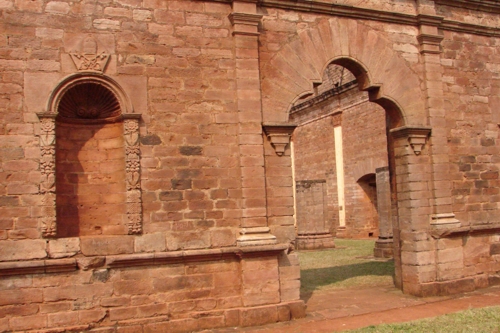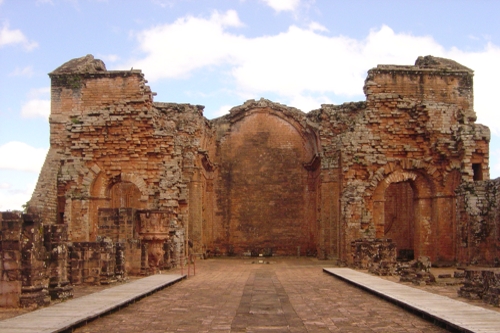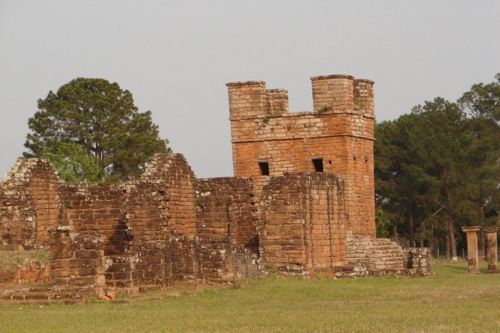The Jesuit World, a fascinating journey into the history, culture and architecture of the 17th century...



The Jesuit reductions were an important historical phenomenon that took place in Paraguay, Argentina and Brazil during the 17th and 18th centuries. These reductions, also known as Jesuit missions, were established by the Society of Jesus with the purpose of evangelizing indigenous populations.
The remains of Jesuit missions are a fascinating tourist destination today and they offer a unique experience for visitors interested in history, culture and colonial architecture.
Some of the reductions have been destroyed or retain few traces of their past glory, but there is still a significant amount in good condition and still in use today mainly in Paraguay. They can be visited thus introducing us to this fascinating part of history.
PARAGUAY
San Ignacio Guazú Reduction, was the first of the Jesuit Mission founded in 1609 at the invitation of famous Guarani chief Arapysandu. It is the oldest of all reductions providing us with an interesting introduction to the Jesuit world.
This town is very easy to access and is located on main Highway 1, 230 km from Asunción and 135 km from Encarnación.
The Jesuit-run Diocesan Museum of Jesuit Guarani Art is housed on the land and strcuture of what served as the Indian habitatiion quarters. The museum has an expressive amount of wood sculptures of Catholic Saints carved out of native hardwoods by Guarani sculptors under the supervision of Italian jesuit priests and artists. Remains of the old church can still be seen in the large museum's yard.
.
Santa María,
The Santa Maria de Fé Mission was founded in 1698. Even though important buildings have been destroyed, among them the orignianl church. Like the neighboring San Ignacio, Santa Maria also has a Diocesan Museum of Jesuit Guarani Art likewise run by Jesuits. The museum has several rooms showing wood-carved statues and images of Saint Mary, Saint Ignatius of Loyola, Saint Francis Xavier, Saint Peter and others all carved by Guarani sculptors using native hardwoods.
All images and statues have survived not only the but also the war that lasted years. The works can be seen in taoday's church and the museum. The visit is worth it.
Santa Rosa, The Santa Rosa de Lima Mission , located about 150 km from Encarnación, in the direction of Asunción, was founded in 1698 with families from Santa María de Fé. In 1883 the original church was destroyed by fire. The most interesting thing is the intact remains of the original bell tower and the chapel of Our Lady of Loreto. In this chapel you can see the frescoes painted on its walls and a group of sculptures representing the Annunciation, a true baroque jewel.
The altar of the current church is decorated with a side altarpiece from the old church, so important that it has become the main altar and is in use today.
As for the urban complex, the square is surrounded by the church and a significant number of houses with galleries with thick stone walls and tile roofs.
Santiago, The Santiago Mission was founded in 1651 and transferred in 1669 to its current location.
Little has remained of the old mission buildings, but the museum almost a replica of the San Ignacio Guazú museum, boasts an original set of statues and plays the role of a large window that opens a splendid introduction to the ruins of the old mission leaving visitors with the feeling of being in a time travel.
San Cosme and Damián, in 1632 Father Adriano Fornoso founded this mission on Portuguese lands. The mission underwent several changes of location until settling down in 1740 where it is now.
One entire city block of the city of San Cosme Damian, for short, is decicated to the Church and a long L-shaped construction that houses social and educational programs up to this day. The Church is the seat of today's Parrish. This mission stands out as a center for astronomical studies in South America, organized by Father Buenaventura Suárez, who maintained contact with the most important astronomers in Europe.
Helped by the Indians, Father Suárez built telescopes, quadrants and a Sundial (admired to this day) that, although rudimentary, provided accurate data. There is a small planetarium where visitors learn about both Western and Guarani Astronomy.
Trinidad, The Santísima Trinidad del Paraná (The Most Holy Trinity of Paraná), located 25 km from Encarnación, is undoubtedly the most interesting, important and suggestive of all the missions.
Trinidad, was declared a World Heritage Site by UNESCO back in 1993. Its main architects were the priests João Batista Prímoli, Milanés and the Catalan José Grimau. Not fully completed, this mission would contain one of the largest and most beautiful churches of all the missions, according to descriptions by travelers of the time.
One of the sacristies houses a small museum with local pieces (original colors) and a model of the mission that should not be missed.
Jesus de Tavarngue, along with the Reduction of Trinidad, the Jesús Reduction has been designated a World Heritage Site by Unesco in 1993.
The Reduction was planned to be the capital for all Reductions in the territory with the aspiration of becoming a town (tava). One of the particularities of Jesús is that it is the only one to have been built using a Moorish inspiration as can be easily seen during a visit.
The original Jesús Reduction was founded in 1685 by the Monday River not far from the world-famous Iguassu Falls. The reduction was transplanted to the present location in 1760 just seven years before the Jeuits were expelled from the Spanish realm in the Americas. The word Tavarangue brings to mind the idea of "former future town".
ARGENTINA
San Ignacio Miní, lies 50 km from Posadas, capital of the Province of Misiones, on the way to Puerto Iguazú/Foz do Iguaçu, it was one of the most prosperous Jesuit missions, being partially restored by the Argentine government.
San Ignacio Miní was founded in 1610 in the area of Guayrá, presently the state of Paraná – Brazil. In 1631, soon after the first slave raids by the notorious Bandeirantes, Father Antonio Ruiz de Montoya led 12,000 Indians on a 1,000 km exodus along the Paraná River. After a painful journey, only 4,000 Indians managed to reach the banks of the Yabebirí River, a tributary of the Paraná. Due to inadequate conditions they were moved to their current location in 1695/6.
The church, centered on the axis of the large plaza, characteristic of all missions, commanded imposing dimensions, decorated with huge polychrome wood carvings, painted with strong colors and a profusion of gold.
Ditches or trenches were built around the entire mission to protect the compound from further possible attacks. At the end of the visit, you will find the mission's collection of items found during the excavations.
Loreto and Santa Ana
Both are close to San Ignacio Miní, due to the actions of time and climate they are in a state of excavation, very little remains of these reductions. Father Ruiz de Montoya, famous in the history of the missions, was buried in Loreto. His remains would have been brought from Lima by his beloved Indians and deposited in the church grounds of this reduction.
BRASIL
San Nicolás, was first founded in 1626 by Father Roque Gonzáles de Santa Cruz, it is named in honor of Father Nicolás Durán Mastrilli.
This mission was hit not only by intense atmospheric phenomena (hurricane in 1684), but also by the attack of the bandeirantes who in 1683 managed to decimate the village and capture 2,000 Indians who were sold as slaves. Little remains of this mission despite its greay past when it was the most populated settlement with 7,751 inhabitants and the largest herds of cattle, sheep and horses.
In the center of the city today, you can see the remains of the main church, a Jesuit winery, a fountain and what could be the sewage system, in addition to some present day houses built with stones taken from the mission.
São Miguel, founded in 1687, is located in the state of Rio Grande do Sul, and has been partially restored by the National Historical and Artistic Heritage Service of Brazil.
Bisides the church designed by the Italian Jesuit Giovanni Primoli and inaugurated in 1754 after nine years of construction, the mission had schools and workshops for goldsmithing, painting, carving, blacksmithing and weaving.
San Miguel also has a museum comparable to that of San Ignacio Guazú and a light and sound show telling the tragic history of the "Sete Povos das Missões" (Seven Pueblos / Villages of the Missions built in what now is Rio Grande do Sul, Brazil).
